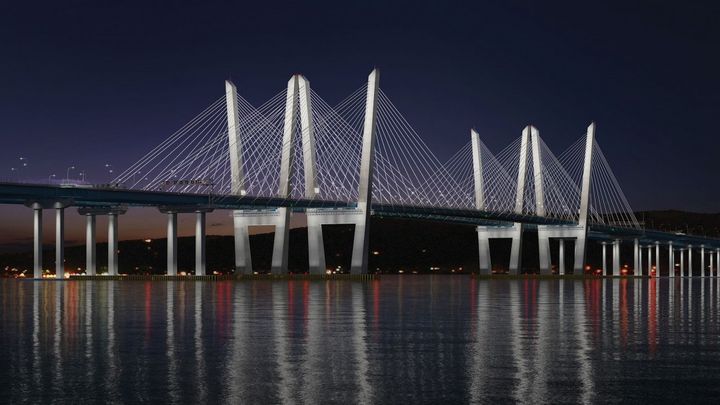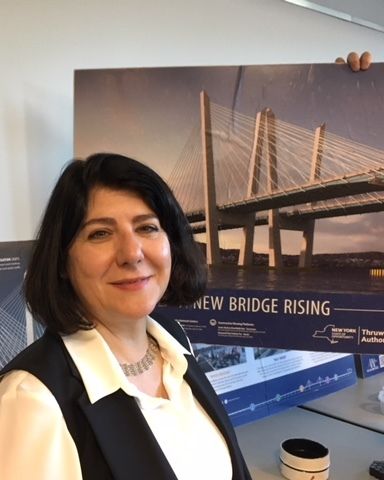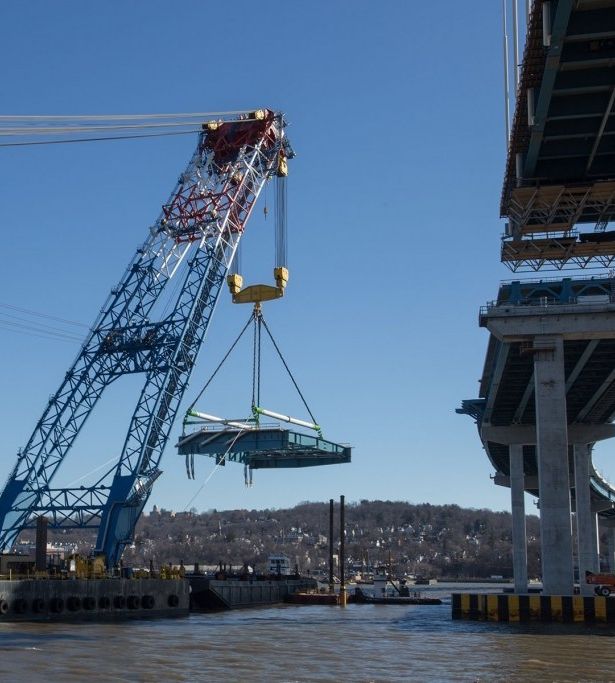
Rendering of the new NY Bridge at night
I moved to Tarrytown in 1950 and watched the barges, carrying caissons, parading down the Hudson River to build the Tappan Zee Bridge. It was built to last 50 years. As a child, 50 years was an endless amount of time; I could hardly imagine anything replacing our state-of-the-art span across one of the widest part of the Hudson. It seemed as if the discussion on when and how to replace the crumbling Tappan Zee also went on for a lifetime. The planning and construction of the new bridge was part of the background noise where I live, less than five miles from where it was happening.
Ta da! The first span of the new Governor Mario M. Cuomo Bridge is now open for business. I just took a ride across and viewed the eight 419-foot, main span towers and the white-encased cable stays, which carry the load of the roadbed over the deepest part of the river, first hand. It is a breathtaking design.

Jamey Barbas, P.E. Project Director
My interest in the bridge was heightened by a recent presentation of the project at my library (Greenburgh, NY) by Jamey Barbas, Project Director for the bridge and a structural engineer by training. As an activist in the Women’s Movement in the seventies, Jamey is what we dreamed of: A competent, visionary engineer who takes on the erection of enormous civil projects, who happens to be female. She remarked that she had been only one of three female engineering majors in college and in graduate school, two of her professors had designed the original Tappan Zee Bridge. So, she is living her own dream and mine.
The New NY Bridge Project has a huge outreach program for anyone who wants to get into the weeds of its construction, its effect on the environment, its dedicated bicycle and pedestrian lanes for recreation, its six viewing platforms, its maintenance program, its boat safety program, its lighting technology and more. Andrew O’Rourke is in charge of Educational Outreach and with his colleague Dan Marcy, has presented to more than 50,000 students in school programs. But my take-away from Jamey’s presentation was simply the scale of the project.
The crossing itself—the roadway—is 3.1 miles long at one of the widest parts of the river. The 2,230-foot elevated main span that allows for ship and boat traffic to pass underneath is built to last 100 years without needing major maintenance. The eight elegant chamfered towers, 5 degrees off the vertical with no cross bars, serves as the structural support for 12 pairs of cables on each side of a tower, that carry the weight of the span, more than 74 million pounds. This innovative design had been approved years ago by hundreds of interested stakeholders. It is already iconic.

February 4, 2017- A 750,000 pound section of structural steel is rigged up to the project’s super crane.
A big construction requires big tools. One of the biggest floating cranes in the world was used to pick up and place the steel girder assemblies for the roadway. Its nickname is “I Lift NY.” It has a 328-foot lift boom and can hoist 1,900 tons of something (equal to 12 Statues of Liberty) and gently lower it to its connection site. For example, it can delicately insert a humongous section of span road-bed by maneuvering it into place with precision accuracy. Although some of the concrete structures were fabricated elsewhere, the towers, in particular, needed specially mixed concrete for the kinds of stresses they would endure. Right in the middle of the river there were as many as three floating concrete batch plants to mix the concrete for the tower segments and keep 20,000 concrete trucks off the road. It is still amazing to me how they can pump this heavy mixture against gravity to where it’s needed.
Jamey Barbas described the orchestration of the deliveries of the components of the bridge, many of which were modular and manufactured elsewhere by American companies. Prior to the start of construction, contracts were signed with the various trades to make sure that people were paid fairly and there would be no stoppages due to labor. They brought in environmental groups to study the effect of the construction on the river and its wild life (there is a peregrine falcon webcam on a nest in the bridge.) I asked her if there were any surprises and she said that they always factor in the unexpected, like weather, in their planning. It’s an engineer’s job to anticipate and solve problems and it seems, when it comes to the New NY Bridge, no stone was left unturned. More than one million hours of thinking went into the design, which was constructed by a consortium of companies totaling 7,000 people contributing nearly 9 million work hours --- check out this video about this huge team effort. It’s amazing what humans can do when they work together!
And here's another video that compresses the four years of construction into 2 minutes.
